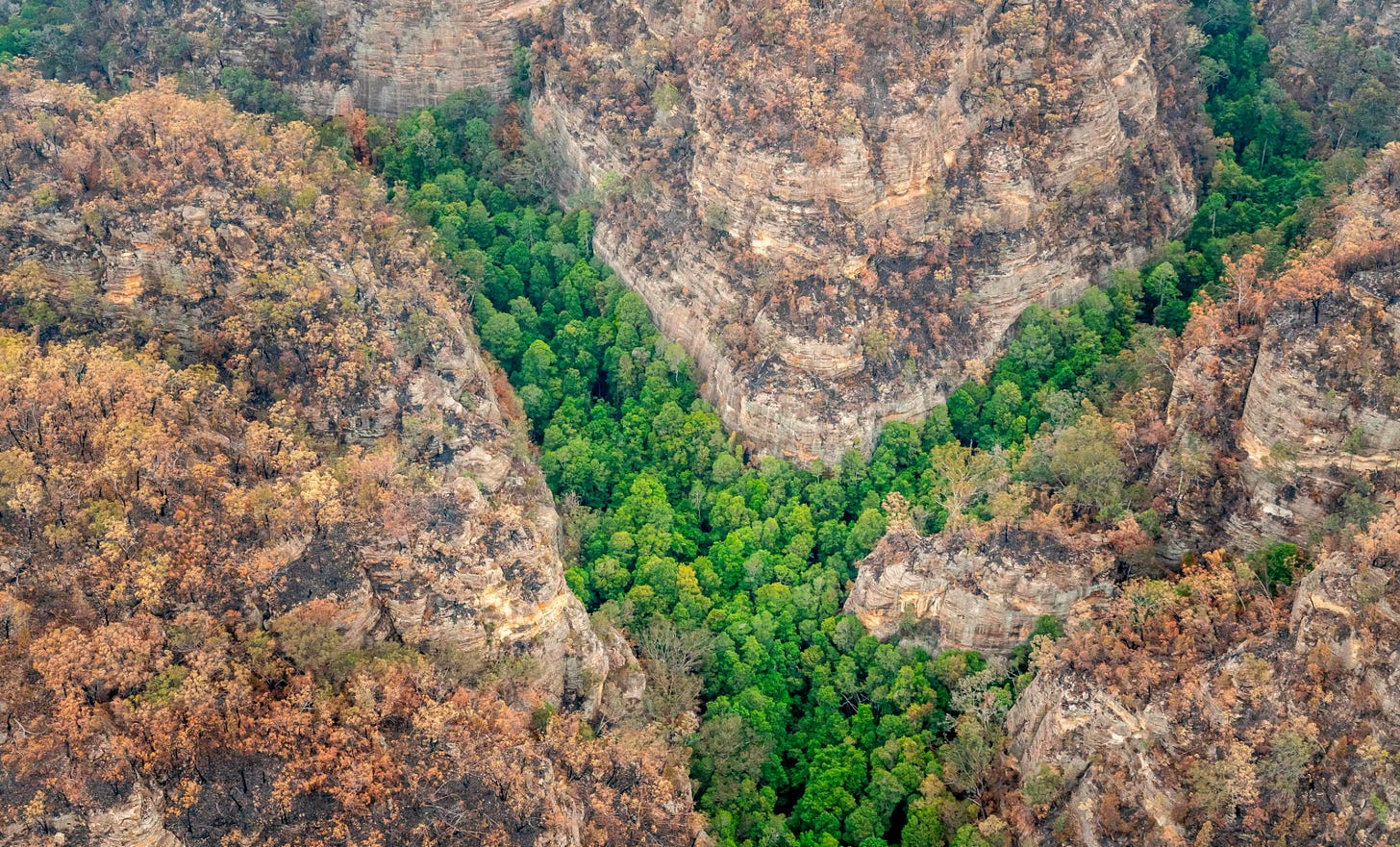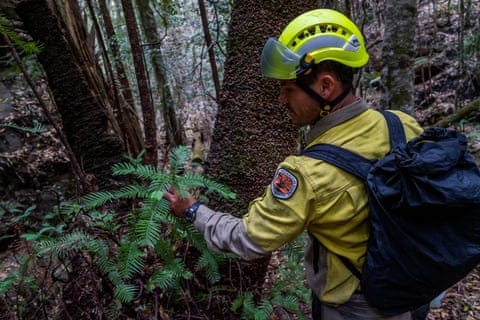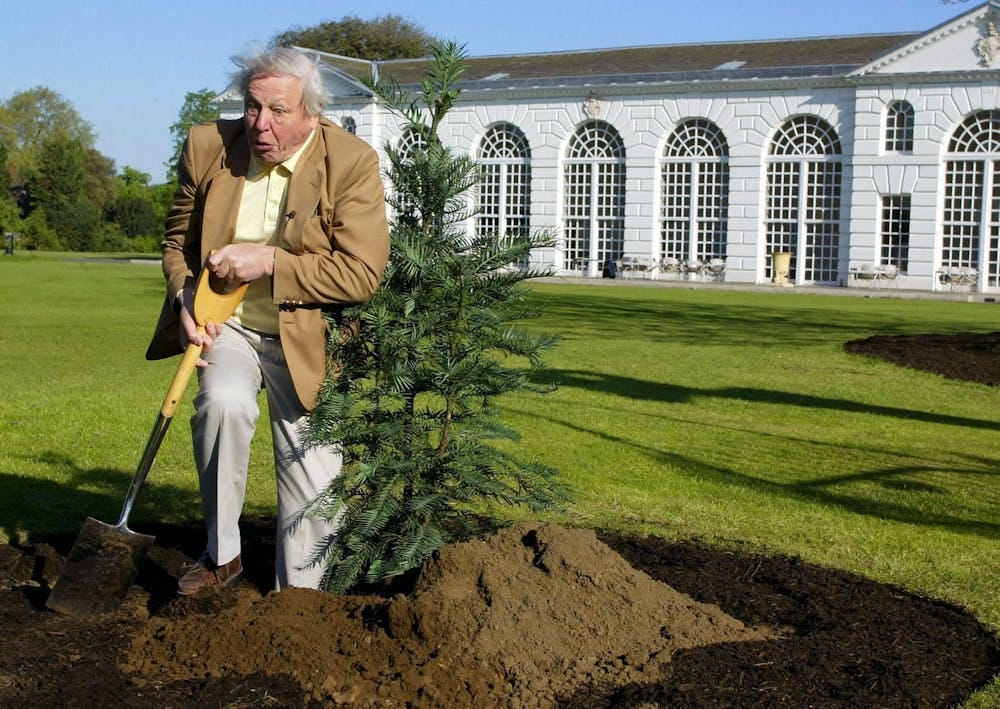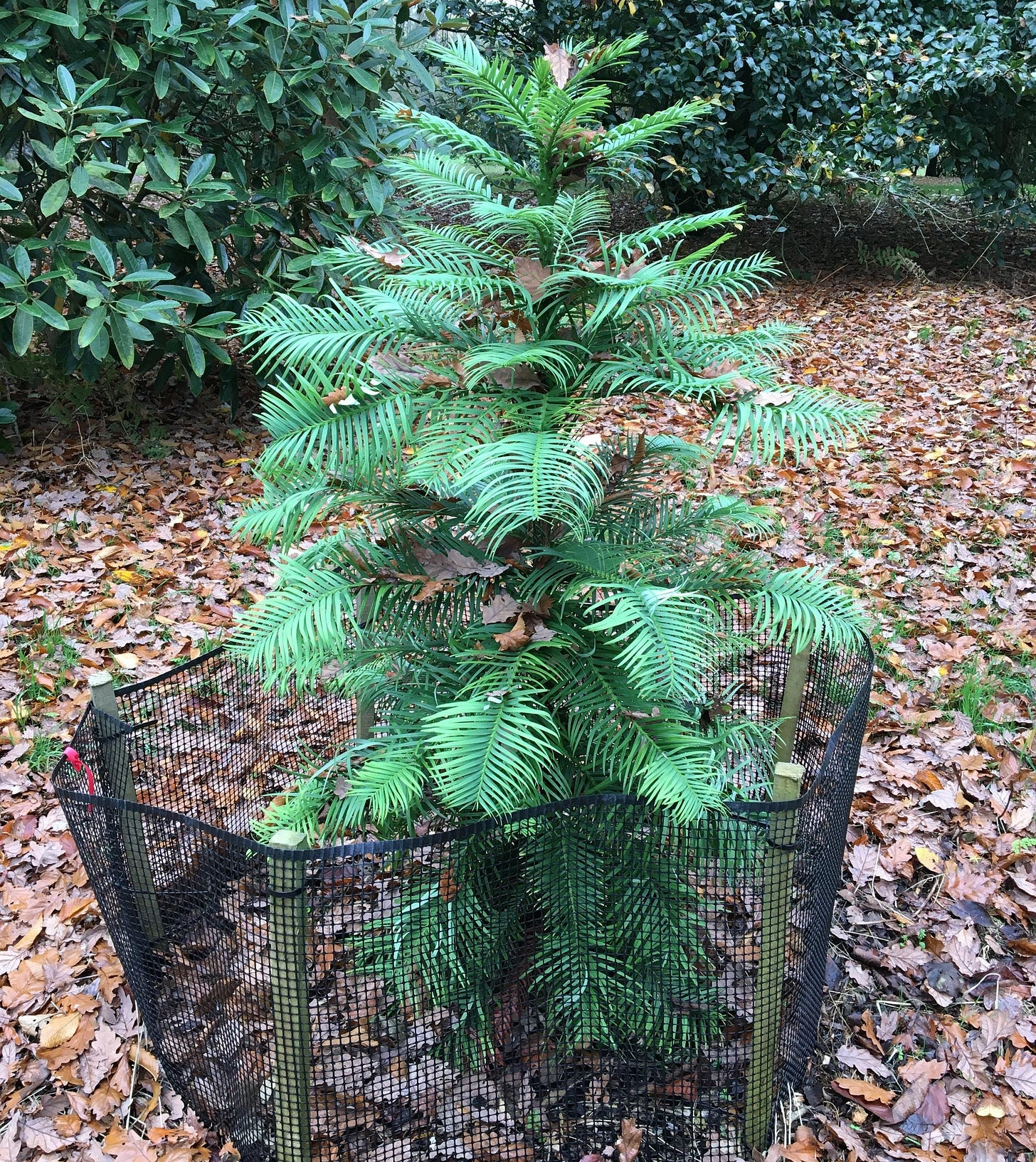Pinosaur: The Sunday Cabinet of Curious Words #3
A Living Relic: The Wollemi Pine and the Global Effort to Save a Prehistoric Wonder. I ran out of words...watch out for Part 2!
The 1994 rediscovery of the Wollemi Pine near Sydney, thought extinct for over 90 million years, is one of botanical history’s most astonishing moments. This “dinosaur tree” has since inspired conservation and hope amid biodiversity loss.
Plant scientist James Wong once reflected, “These majestic conifers... are set to continue not just surviving but thriving into the future.” His words echo the wonder and ambition of a global effort now decades in the making.
The 1994 rediscovery of the Wollemi Pine, thought extinct for over 90 million years, was a landmark in botanical history. Known as the “dinosaur tree” or “pinosaur,” it has inspired conservation and hope amid biodiversity loss. To protect wild trees—fewer than 100 remain—the species was made commercially available to prevent illegal collection, while conservation focuses on safeguarding originals and building new populations through a global metacollection.
Today, thousands of Wollemi Pines grow in Australian reserves and gardens across 31 countries, cared for by over 1,500 people worldwide. Once believed extinct for 2 million years, the Wollemi Pine now stands as a powerful symbol of hope, uniting scientists and gardeners worldwide to save this ancient tree.
Denise Ora, Chief Executive of the Botanic Gardens of Sydney, highlights the magnitude of this mission: “The world fell in love with this curious conifer... and we have been dedicated to safeguarding this rare species from extinction.”
But it also raises deeper questions:
Why do we so often ignore plants when we talk about extinction?
Why are they so rarely included in the stories we tell about the past and the future of life on Earth?
The Inspiration - Sadiah Qureshi
This topic was brought to my attention by Professor Sadiah Qureshi from the University of Manchester, who gave a talk in Cambridge a few weeks ago. I hadn’t heard about it before, but it really grabbed me, mostly because I love plants and dinosaurs. A Pinosaur? Right up my alley.
Professor Qureshi is a historian focused on race, science, and empire. She studies how racialised knowledge has shaped global views on life and still impacts issues like antiracism, land rights, and conservation. Her latest book, Vanished: An Unnatural History of Extinction (2025), was released on World Environment Day and named a must-read by the Financial Times. It combines histories of science, race, genocide, empire, and conservation, using examples from America to Australia to explore how extinction became a concept and shapes our understanding of life today. She shares her research through talks and podcasts, and urges us to include plants in our histories to rethink extinction and how we value life.1
The History
The discovery happened on September 10, 1994, when Australian canyoner and explorer David Noble, along with Michael Casteleyn and Tony Zimmerman, were out exploring remote gorges in search of new canyons.2 While navigating one of these hidden valleys, they noticed some unusual trees with striking, bubbly bark that stood out immediately as something worth looking into.

Samples were collected for the study, drawing attention from plant experts like Bleddyn and Sue Wynn-Jones, who specialise in finding rare species for cultivation. They were supported by Ian Allen of Blue Mountains Botanic Garden and botanist Kenneth D. Hill from the Royal Botanic Gardens, Sydney.3 The first illustrations were made by David Mackay, a skilled botanical artist at the Royal Botanic Gardens, Sydney, who has also worked at Kew Gardens, UC Berkeley, and the Linnean Herbarium.4
Fewer than 60 adult Wollemi Pines are known in the wild, spread across four close sites. Counting is tricky because many have multiple stems and may share roots. Genetic tests show they’re almost identical, pointing to a severe bottleneck 10,000 to 26,000 years ago. Bottlenecks like this cut genetic diversity sharply, usually after disasters like fires, floods, disease, or human impact, leaving future generations with limited variation.5 With fewer than 100 of these trees surviving in the wild, the Wollemi pine was soon listed as critically endangered on the International Union for Conservation of Nature’s Red List, a global alarm system for species on the brink.6
As of June 2024, 45 adult trees remain in the wild, with 19 at the largest site.
Threats to the trees
Wollemi Pines grow very slowly, less than a centimetre per year, and only mature once they reach the canopy. Secret translocation sites serve as safe backup populations because the original wild group was so small that it could have easily been wiped out. These sites are legally protected, with heavy fines and jail time for unauthorised visits. The team visits rarely and follows strict disinfection rules to prevent disease.
"One of the biggest dangers that we have is that people actually come and visit these. We know people want to, but they really can't," NSW Environment Minister Penny Sharpe said.
The survival of Wollemi Pines depends on stopping the spread of Phytophthora cinnamomi, or cinnamon fungus, an invisible soil-borne pathogen that causes root rot and dieback. It has already infected part of the original grove, likely from contaminated soil. Even tiny amounts can spread it, and there’s no cure, only damage control. Protecting translocation sites is vital because infected trees will likely die. The public must respect the secrecy of these sites, as illegal visits risk both breaking the law and destroying the species. 7
Bushfires and climate change are major threats. In the 2019–2020 bushfires, most Wollemi Pines at translocation sites were destroyed, leaving only a few survivors. Specialist firefighters from the National Parks and Wildlife Service and the Rural Fire Service saved what they could using irrigation and fire retardant. Hundreds more were planted in 2021 to help recovery. Luckily, most mature trees in the original grove survived. 8

Lisa Menke, an area manager at the Blue Mountains branch of the NPWS, said they were able to save most of the original grove where the mature trees were, but it could have been a very different outcome.
"We were lucky ... the fire actually came through overnight, which meant that it was a bit cooler than if it had come roaring through during the middle of the day,"
Preservation and Conservation
Wild Wollemi pines face serious threats from disease and wildfires. They narrowly survived the devastating 2019–2020 bushfires that burned over 10 million hectares in eastern Australia. As a critically endangered species, conservationists have launched wide-ranging protection and propagation efforts. Genetic advances now enable growing diverse saplings, which are shared worldwide to preserve genetic diversity and boost resilience to climate change.

A global partnership between Forestry England, Sydney Botanic Gardens, and BGCI has established climate-suitable gardens worldwide to grow and study Wollemi pines. Using data from a 2005 citizen science project, sites were chosen to support the species’ spread. Though less genetically diverse than wild trees, these collections help conserve the species. For over 30 years, scientists have built a diverse living collection and seed bank, sharing trees from Australian gardens to sites across the UK, Europe, Australia, and the USA.9
A cool milestone? A Wollemi pine in a Worcestershire garden in the UK produced cones for the first time. It is a hopeful sign that these trees are thriving and multiplying.10 There’s also been high-profile support, with Australian prime ministers and foreign ministers gifting Wollemi pines to leaders around the world, raising global awareness. Sir David Attenborough planted a Wollemi pine at Kew Gardens in West London in May 2005.11 Forestry England’s Bedgebury National Pinetum grows over 2,000 seedlings annually. Some stay onsite, but many are shared with botanical gardens and protected sites across the UK and Europe.12
To protect these rare pines, a Recovery Plan spells out how to manage and conserve them going forward. The plan is available online: Wollemia nobilis (Wollemi Pine) Recovery Plan (PDF) (Report). New South Wales Department of Environment and Conservation.
Conversations to be had
The Wollemi Pine, dubbed a “living fossil”, complicates dominant narratives of extinction by drawing attention to deep time, nonhuman agency, and the limits of anthropocentric history. Its survival prompts critical reflection on colonialism, biodiversity, and the politics of conservation, positioning plant life not as background to human affairs but as part of a shared, entangled history.
Historians such as Ritvo, Grove, van Dooren, and Chatterjee, alongside decolonial and Indigenous scholars, have questioned the Eurocentrism and human exceptionalism of conventional historical frameworks. The Wollemi Pine exemplifies the historiographical challenge of narrating extinction across geological and political timescales, and within overlapping scientific, cultural, and ethical discourses.
While celebrated as a national symbol, the Pine’s public framing often reproduces colonial logics. It is marketed as an Australian treasure with little reference to Indigenous knowledge systems or stewardship. This reflects a broader pattern in conservation practice: settler institutions extract symbolic and scientific value while erasing the histories and ecologies they displace.
Revival projects, efforts to conserve, rewild, or resurrect species, are similarly fraught. Though framed as acts of care, they frequently reinforce technoscientific control and marginalise Indigenous ecologies. Concepts such as Tsing’s “contaminated diversity” and Thompson’s critique of the native/nonnative binary challenge restorationist fantasies, urging more honest engagement with ecological change and cultural complexity.
Ultimately, conservation must move beyond nostalgia, scientific optimism, or national pride. It demands critical attention to history, justice, and the limits of human intervention. Without this, ecological revival risks becoming an exclusionary project of control rather than care.
An expanded discussion of these themes—including further engagement with historiography, Indigenous epistemologies, and the politics of ecological restoration—follows in Part 2. I run out of words!
Definition
As usual, we come to an end. What is a pinosaur?
Pinosaur (noun)
Humorous, informal.
Plural: pinosaurs
Definition:
A colloquial term for the Wollemi Pine (Wollemia nobilis), an ancient and extremely rare conifer native to Australia, often described as a “living fossil.” The word is a blend of pine and dinosaur, evoking the species’ survival since the time of the dinosaurs, over 90 million years ago.
Presumed extinct and known only through fossil evidence, the pinosaur was rediscovered in 1994 in a remote canyon in Wollemi National Park, prompting international attention and extensive conservation efforts. The term is used to highlight the tree’s extraordinary evolutionary longevity and its symbolic role in contemporary debates about extinction, conservation, and ecological restoration.
Today, the pinosaur serves not only as a scientific curiosity but also as a cultural emblem, raising questions about deep time, human intervention in nature, and the colonial legacies of conservation science.
Before I once again run out of words, we shall end here. Please check out Part 2, which will be released soon! As always, it was a pleasure to have you here. Forever yours.
— Historian of Science and Medicine
Sadiah Qureshi - Research Explorer, the University of Manchester. Available at: https://research.manchester.ac.uk/en/persons/sadiah-qureshi (Accessed: 15 June 2025).
Woodford, James (2002). The Wollemi Pine: The incredible discovery of a living fossil from the age of the dinosaurs. Melbourne: Text Publishing.
Gardens: Crûg Farm’s buried treasure (2012) The Guardian. Available at: https://www.theguardian.com/lifeandstyle/2012/jun/17/crug-farm-wales-gardening-dan-pearson (Accessed: 15 June 2025).
Botanical & Wildlife Artist: Australia: David Mackay (no date) davidmackay. Available at: https://www.davidmackay.com.au/ (Accessed: 15 June 2025).
Stevenson, Dennis Wm.; Ramakrishnan, Srividya; Alves, Cristiane de Santis; Coelho, Laís Araujo; Kramer, Melissa; Goodwin, Sara; et al. (2023). The genome of the Wollemi pine, a critically endangered "living fossil" unchanged since the Cretaceous, reveals extensive ancient transposon activity (preprint). doi:10.1101/2023.08.24.554647.; Peakall, Rob; Ebert, Daniel; Scott, Leon J.; Meagher, Patricia F.; Offord, Cathy A. (2003). "Comparative genetic study confirms exceptionally low genetic variation in the ancient and endangered relict conifer, Wollemia nobilis (Araucariaceae)". Molecular Ecology. 12 (9): 2331–2343.
NSW National Parks and Wildlife Service 2021. Wollemia nobilis. The IUCN Red List of Threatened Species. Version 2025-1, https://www.iucnredlist.org/species/34926/276111449.
“Phytophthora dieback". Australian Government - Department of Climate Change, Energy, the Environment and Water. 3 October 2021; Salleh, Anna (4 November 2005). "Wollemi pine infected by fungus". abc.net.au. Science articles. Australian Broadcasting Corporation.
Hannam, Peter (15 January 2020). "Incredible, secret firefighting mission saves famous 'dinosaur trees'". The Sydney Morning Herald.; Morton, Adam (15 January 2020). "Firefighters save endangered Wollemi pines from NSW bushfires". The Guardian.
Pacific Horticulture | Humboldt Botanical Gardens. Pacific Horticulture.
Prehistoric and Critically Endangered 'Dinosaur Tree' Bears Fruit for First Time in British Couple's Garden". Good News Network. 2025-04-26
Brack, Cris (15 June 2018). "Wollemi pines are dinosaur trees". The Conversation
Bedgebury National Pinetum and Forest (no date) Forestry England. Available at: https://www.forestryengland.uk/bedgebury (Accessed: 15 June 2025).




